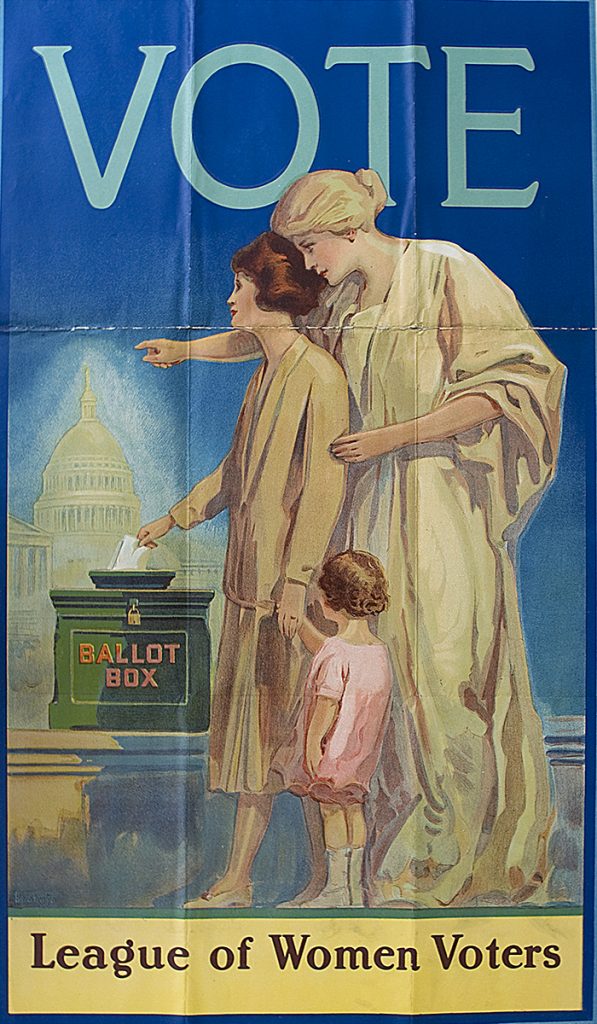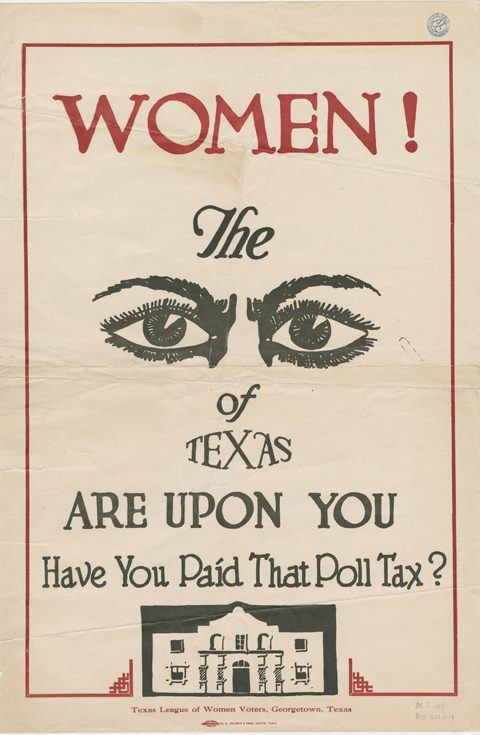Background
The Nineteenth Amendment to the Constitution was ratified on August 18, 1920. It declared the right to vote could not be denied on the basis of sex. On Election Day 1920, only one-third of eligible women voted. Many former suffragists were disappointed by this statistic. The focus of their activism shifted almost immediately. Women had the vote. They needed to exercise it.
The National American Women’s Suffrage Association became the League of Women Voters in 1920. The organization was a nonpartisan group that encouraged women to vote and educated women about their rights as voters. They held meetings and rallies and distributed information. Posters were an important means of communication.
About the Image
These two posters were created by local chapters of the League of Women Voters.
The first poster is from Virginia. It shows a woman voting. Behind her, an allegorical figure places a comforting hand on the voter’s arm. She points toward the Capitol building, suggesting that the woman’s vote will have an impact on the biggest political stages. The voter has brought her daughter, who represents the future. Both mother and daughter look toward the Capitol building in contemplation.
The second poster is from Texas. It shows a pair of eyes looking intensely at the viewer. Unlike the gentle allegorical figure in the first poster, the eyes are powerful and judgmental. The building at the bottom of the poster is the historic Alamo, a symbol of Texas independence. The poster reminds women to pay their poll tax, which was a required step in the Texas voter registration process. Poll taxes were one of many strategies effectively used by local and state governments in the South to prevent Black and low-income citizens from voting. Such policies ensured African American men and women could not vote. The inclusion of the poll tax is evidence that the League of Women Voters reinforced the color line and did not resist laws that barred many women from voting. In the wake of the Nineteenth Amendment, many Americans hoped that white middle-class women voters would be a counterbalance to the Black vote. The League of Women Voters’ focus on white middle-class women only reinforced this idea.
Vocabulary
- Alamo: The Alamo was a mission in San Antonio, Texas, that served as a fort during the Texas revolution. The battle at the Alamo in 1836 resulted in the deaths of 187 Texan revolutionaries. Since then, the fort has served as a symbol of Texan bravery and independence.
- allegorical: Symbolic or representative.
- counterbalance: A weight or force that balances against another weight or force.
- League of Women Voters: A nonpartisan activist group made up of local chapters across the country that was founded in 1920. It educated women about voting rights and encouraged them to vote. Prior to 1920, it was known as the National American Woman Suffrage Association.
- Nineteenth Amendment: The constitutional amendment that declared the right to vote could not be denied on the basis of sex; it was ratified in 1920.
- poll tax: A tax a voter must pay before voting. Poll taxes were often used to prevent low-income people (particularly African Americans) from voting.
- ratification: The process by which an amendment to the federal Constitution is approved or rejected by states.
Discussion Questions
- What similarities and differences do you notice between these two posters?
- Why did the League of Women voters create posters like this? What was their goal? Why were posters an effective strategy?
- What stereotypes about women voters do these posters present? To what extent does each promote a limited view of the kinds of women who voted?
- How does the first poster promote traditional views of womanhood and motherhood? How does it create a limited view of women citizens? Who does it exclude?
- Why is the inclusion of the poll tax in the second poster important? What does it say about voting in Texas at that time?
Suggested Activities
- APUSH Connection: 7.8: 1920s: Cultural & Political Controversies
- Explore the turning point between the long fight for suffrage and the dawn of the woman voter. Combine these posters with materials from the Woman Suffrage section in Modernizing America: 1889–1920.
- Compare these posters with the Suffrage poster by Rose O’Neill, and consider how each poster portrays women and defines the ideal woman voter.
- Combine the second poster with the photograph of anti-suffragists in Tennessee, the 1920 NAACP testimony before Congress, and additional resources from the Black Citizenship in the Age of Jim Crow curriculum. Consider how each piece speaks to the complex relationship between race, gender, and voting.
Themes
POWER AND POLITICS; AMERICAN IDENTITY AND CITIZENSHIP








